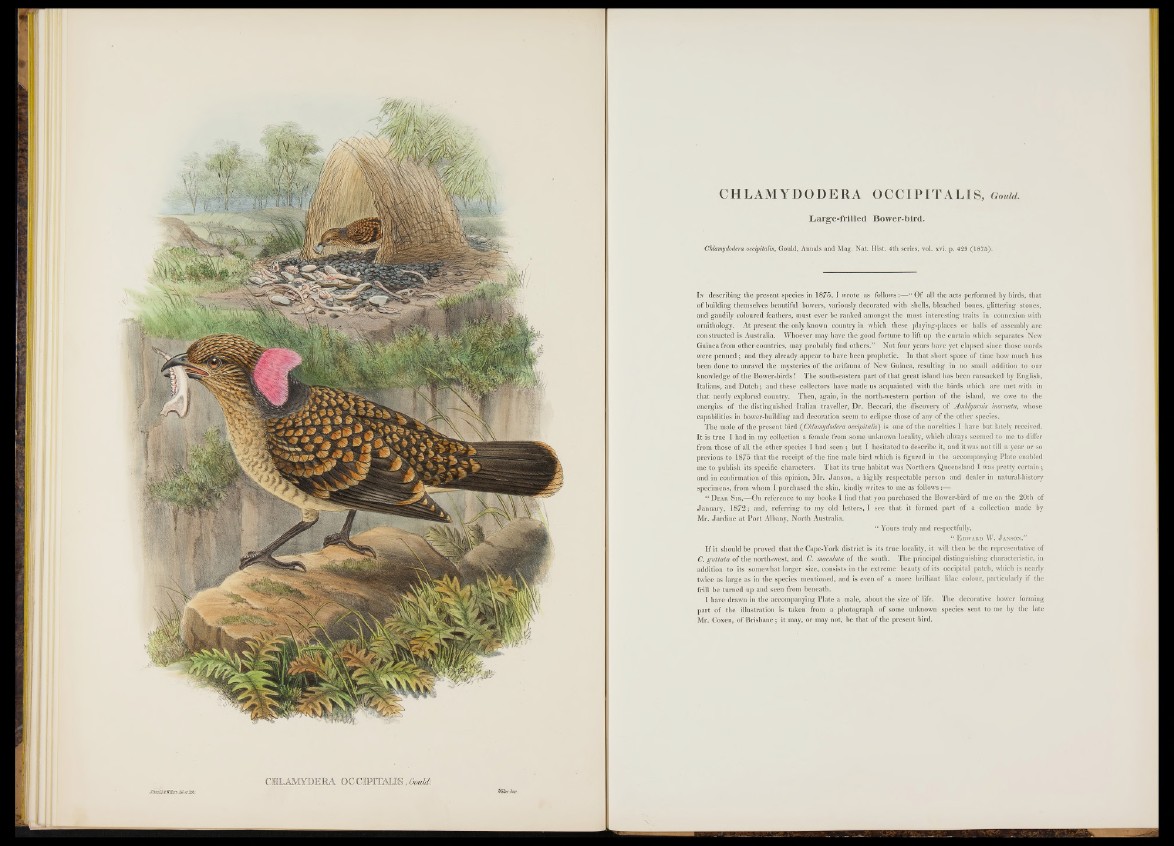
CHLAMYDEEA OCCIMTAIIS. GouU>.
JtvulJ kXJint 3A cthth/.
CHLAMYDODERA OCCIPITALIS, Gould.
Large-frilled Bower-bird.
Chlamydodera occipitalis, Gould, Annals and Mag. Nat. Hist. 4th series, vol. xvi. p. 429 (1875).
In describing the present species in 1875, I wrote as follows:— “ Of all the acts performed by birds, that
o f building themselves beautiful bowers, variously decorated with shells, bleached bones, glittering stones,
and gaudily coloured feathers, must ever be ranked amongst the most interesting traits in connexion with
ornithology. At present the only known country in which these playing-places or halls o f assembly are
constructed is Australia. Whoever may have the good fortune to lift up the curtain which separates New
Guinea from other countries, may probably find others.” Not four years have yet elapsed since those words
were penned; and they already appear to have been prophetic. In that short space of time how much has
been done to unravel the mysteries o f the avifauna o f New Guinea, resulting in no small addition to our
knowledge o f the Bower-birds ! The south-eastern part o f that great island has been ransacked by English,
Italians, and Dutch; and these collectors have made us acquainted with the birds which are met with in
that newly explored country. Then, again, in the north-western portion o f the island, we owe to the
energies o f the distinguished Italian traveller, Dr. Beccari, the discovery of Amblyornis inornata, whose
capabilities in bower-building and decoration seem to eclipse those o f any o f the other species.
The male of the present bird ( Chlamydodera occipitalis) is one of the novelties I have but lately received.
It is true I had in my collection a female from some unknown locality, which always seemed to me to differ
from those of all the other species I had seen ; but I hesitated to describe it, and it was not till a year or so
previous to 1875 that the receipt o f the fine male bird which is figured in the accompanying Plate enabled
me to publish its specific characters. That its true habitat was Northern Queensland I was pretty certain ;
and in confirmation of this opinion, Mr. Janson, a highly respectable person and dealer in natural-history
specimens, from whom I purchased the skin, kindly writes to me as follows:—
“ D e a r S ir ,— On reference to my books I find that you purchased the Bower-bird o f me on the 20th of
January, 1872; and, referring to my old letters, I see that it formed part o f a collection made by
Mr. Jardine at Port Albany, North Australia.
“ Yours truly and respectfully,
“ E dw a r d W. J a n so n .”
If it should be proved that the Cape-York district is its true locality, it will then be the representative of
C. guttata of the north-west, and C. maculata of the south. The principal distinguishing characteristic, in
addition to its somewhat larger size, consists in the extreme beauty o f its occipital patch, which is nearly
twice as large as in the species mentioned, and is even of a more brilliant lilac colour, particularly if the
frill be turned up and seen from beneath.
I have drawn in the accompanying Plate a male, about the size o f life. The decorative bower forming
part o f the illustration is taken from a photograph o f some unknown species sent to me by the late
Mr. Coxen, o f Brisbane; it may, or may not, be that of the present bird.